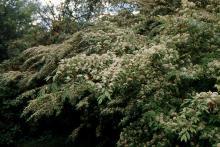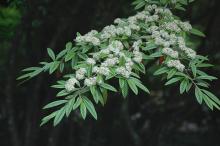Cotoneaster salicifolius
Common name:
Willowleaf Cotoneaster
Pronunciation:
ko-to-nee-AS-ter sal-is-i-FOL-lee-us
Family:
Rosaceae
Genus:
Type:
Broadleaf
Native to (or naturalized in) Oregon:
No
- Evergreen shrub, 6-8(15) ft [1.8-2.4(4.5) m], spreading, arching to horizontal. Leaves alternate, simple, willow-like, 4-9 cm long and 0.8-2.0 cm wide, 5-9 prominent impressed vein pairs, dark green, wrinkled above, pubescent and glaucous below. Some yellow and red leaves in fall and purplish in winter. Flowers, small, solitary, and white, borne in 5 cm woolly flat-topped clusters; have an unpleasant odor. Fruit in clusters, bright red, each ca. 6 mm wide, subglobose, contain 2-3 nutlets, persists during winter.
- Sun to part shade, best in a moist, well-drained acid or neutral soil.
- Hardy to USDA Zone 6 Native to Western China. Several cultivars, some are rather compact, dwarf, or low growing (see C. salicifolius 'Autumn Fire').
- salicifolius: willow-like leaves [salix: willow, and folius: leaves(foliage)]
- Oregon State Univ. campus: NW of Gilkey Hall on Campus Way






